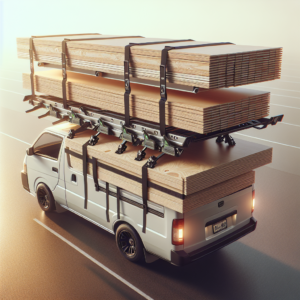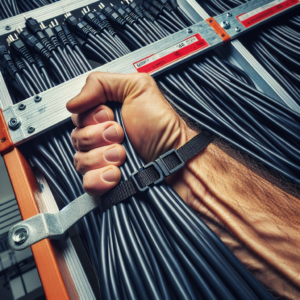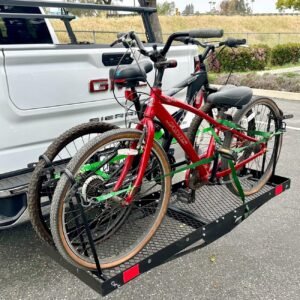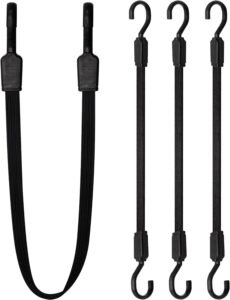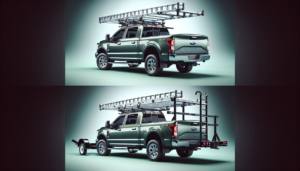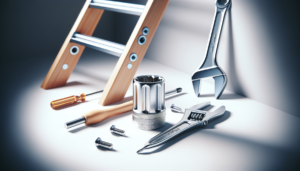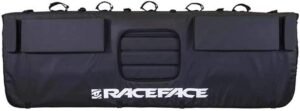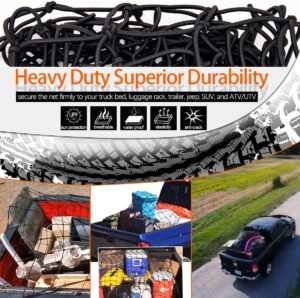
If you’ve ever found yourself scratching your head over how to safely transport ladders with irregular shapes or unconventional dimensions on a ladder rack, fret no more. In this article, we’ll explore the various methods and solutions to tackle this tricky task, ensuring that your ladders remain securely in place during transit. Whether you’re a professional tradesperson or a weekend DIY enthusiast, these tips will help you make the most of your ladder rack and keep your prized equipment safe and sound.
Choose the Right Ladder Rack
When it comes to choosing the right ladder rack for your needs, there are a few factors to consider. First and foremost, you’ll want to make sure the ladder rack is compatible with the type of ladder you will be securing. Different ladder racks are designed to accommodate specific ladder styles, so it’s important to choose one that is suitable for your particular ladder.
Additionally, you’ll want to think about the weight capacity of the ladder rack. Make sure it can safely hold the weight of your ladder, as well as any additional equipment or materials you may need to transport. It’s always better to choose a ladder rack with a higher weight capacity than you think you’ll need, just to be on the safe side.
Finally, consider the installation process. Look for a ladder rack that is easy to install and adjust, so you can quickly and efficiently secure your ladder when needed. Some ladder racks may require professional installation, while others can be easily installed by yourself.
Inspect and Measure the Ladder
Before securing your ladder to the rack, it’s important to inspect it for any damage. Look for any cracks, dents, or loose parts that could compromise the integrity of the ladder. If you notice any damage, it’s best to repair or replace the ladder before attempting to secure it to the rack.
In addition to inspecting the ladder for damage, you’ll also want to measure its dimensions. This will help ensure that the ladder rack you choose is the right fit for your ladder. Measure the length, width, and height of the ladder, as well as any irregular or unconventional shapes. Having accurate measurements will make it easier to select the appropriate rack accessories and securing devices.
Use Adjustable Rack Accessories
When securing a ladder with irregular shapes or unconventional dimensions, adjustable rack accessories can make all the difference. These accessories are designed to accommodate various ladder shapes and sizes, providing a secure and stable fit.
Consider using ladder stoppers, which are adjustable brackets that can be positioned at different points along the ladder rack. These stoppers help prevent the ladder from sliding or shifting during transport, providing an extra layer of security.
For ladders with irregular shapes, such as those with rounded or tapered ends, ladder brackets can be deployed. These brackets can be adjusted to fit the specific shape of your ladder, ensuring a snug and secure fit on the ladder rack.
In addition to ladder stoppers and brackets, ladder clamps can also be installed for extra security. These clamps securely hold the ladder in place, preventing it from shifting or falling off the rack during transit.
Apply Padding and Cushioning
To protect your ladder from damage during transportation and prevent it from scratching or denting your vehicle, consider applying padding and cushioning. Foam or rubber padding can be placed on the ladder rack or along the contact points between the ladder and the rack.
In addition to padding, you can also wrap the ladder with bungee cords or straps. This not only provides cushioning but also adds an extra layer of security by keeping the ladder tightly secured to the rack.
Utilize Tie-Down Straps
When it comes to securing ladders with irregular shapes or unconventional dimensions, tie-down straps are a reliable option. Choose appropriate tie-down straps based on the weight and size of your ladder, ensuring they have a high weight capacity and are specifically designed for securing ladders.
To secure the ladder, start by attaching one end of the tie-down strap to the ladder rack or anchor point on your vehicle. Then, crisscross the straps over the ladder in a secure pattern, making sure they are cinched tight. This crisscross pattern helps distribute the tension evenly and provides a strong hold.
Use Ratchet Straps or Buckles
For added security and ease of use, ratchet straps or buckles can be an excellent choice when securing ladders. These devices allow you to apply tension to the straps while keeping the ladder aligned and firmly in place.
Opt for ratchet straps or buckles that are specifically designed for securing ladders. These straps typically have a high weight capacity and are constructed with durable materials to ensure a safe and secure hold.
To use ratchet straps or buckles, follow the same procedure as with tie-down straps. Attach one end to the ladder rack or anchor point, crisscross the straps over the ladder, and tighten them using the ratchet or buckle mechanism. Always ensure that the straps are tightly secured and the ladder is properly aligned before hitting the road.
Consider Locking Devices
To add an extra layer of security and deter theft, consider using locking devices when securing your ladder. Ladder locks or chain locks can be used to secure the ladder to the ladder rack, making it more difficult for anyone to remove the ladder without your permission.
To use ladder locks or chain locks, simply wrap them around the ladder and the ladder rack, and secure them with a padlock or combination lock. This will prevent unauthorized access to the ladder and provide peace of mind during transportation and storage.
Employ Bungee Cords or Bungee Nets
If you’re looking for a flexible and versatile option to secure your ladder, bungee cords or bungee nets can be an excellent choice. These elastic cords or nets can be easily stretched and wrapped around the ladder and the ladder rack, creating a secure webbing pattern.
When choosing bungee cords or nets, make sure to select high-quality ones that can withstand the weight and tension of your ladder. Look for cords or nets with strong hooks and adjustable lengths to ensure a secure and customized fit.
To secure the ladder using bungee cords or nets, start by wrapping them around the ladder and the ladder rack, crisscrossing the cords or overlapping the nets for added stability. Make sure they are tightly secured, but not overly stretched, to maintain a secure hold.
Add Secondary Supports
To further enhance the stability and safety of your ladder when secured to a ladder rack, consider adding secondary supports. Additional support bars or brackets can be attached to the ladder rack to provide extra reinforcement and prevent any movement or shifting.
Furthermore, ladder edge protectors can be installed to minimize the risk of damage to your ladder and the vehicle. These protectors act as a buffer between the ladder and the rack, reducing the chance of scratches, dents, or other forms of damage.
By adding these secondary supports, you can have peace of mind knowing that your ladder is well-supported and protected during transit.
Regularly Check and Retighten
Once your ladder is securely fastened to the ladder rack, it’s important to regularly check and retighten the securing devices. Over time, vibrations from the road and other external factors can cause straps, cords, or locks to loosen.
Make it a habit to periodically inspect the ladder and all the securing devices to ensure they are still in good condition. Check for any signs of wear and tear, and replace any damaged or compromised components. Additionally, tighten all the straps, cords, or locks to maintain a secure hold.
By regularly checking and retightening the securing devices, you can ensure that your ladder remains stable and secure during transportation, preventing any accidents or damage.
In conclusion, securing ladders with irregular shapes or unconventional dimensions on a ladder rack requires careful consideration and the right equipment. By choosing the right ladder rack, using adjustable rack accessories, applying padding and cushioning, utilizing tie-down straps or ratchet straps, considering locking devices, employing bungee cords or nets, adding secondary supports, and regularly checking and retightening, you can safely and securely transport your ladder without any worries. Remember, the safety of your ladder and those around you should always be a top priority when using a ladder rack.
